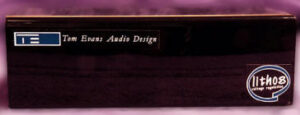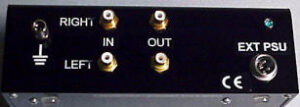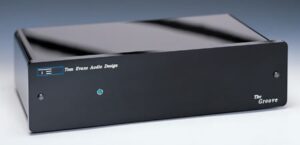Life is good. Thanks to the kind assistance of Jay Kaufman at Audio Revelation, I was able to enjoy a complete audition of the Tom Evans Microgroove+ phono preamplifier. Jay has some demo units that float among prospective customers and permit the kind of unhurried, in-home auditions that help you make a good buying decision, hopefully eliminating buyer’s remorse a month or two later. Long auditions used to be common in the high-end industry, but this seems to be fading fast. For example, one of Denver’s oldest high-end stores now requires that you purchase a demo component before rushing home for an overnight audition.
The Microgroove+ is very quiet, a characteristic which I have come to consider to be a basic requirement of audio components in general and phono preamplifiers in particular. The reason to pay particular attention to the signal-to-noise ratio of phono stages is the amount of gain they provide. A typical moving coil phono stage amplifies the cartridge’s tiny voltage about 50 to 70 dB, depending on the model. To increase your cartridge’s 0.5 millivolt output to 1 volt “line level”, the phono stage must multiply the signal strength by 2,000 times! Compare that to a line stage – 5 to 10 times, or to a power amplifier – about a 20 times increase. The phono stage not only provides the greatest amplification in the audio chain, but starts with very tiny, almost immeasurable voltages that are very fragile in their complex construction. The common wisdom is true: it does not matter if you have the finest speakers on the planet if the signal is corrupted earlier in the chain. Since the phono stage provides about 98% of the overall system gain, this is the one component where compromises should NOT be made!

With this in mind, I was lucky to spend about two weeks with the Microgroove+, and if you hear this over-achiever, you will feel lucky, too. Please see the manufacturer’s Web site for technical information. At $1900 for a small plastic box and an outboard power supply, I was not initially impressed that this unit would offer good value for the money. That impression lasted exactly until the installation was complete and the needle hit the first cut. From the first five minutes until two weeks later when I packed up the Microgroove+ for shipment to the next potential customer (he’ll buy!), the following reaction to the Microgroove+ was consistent.
This is not a so-called “budget” product. Over two weeks of analytical listening, background listening, and just listening for pleasure, I repeatedly tried to find some specific weakness in the presentation of the Microgroove+. After all, I’ve heard a lot of good stuff, so I assumed that it would be easy to pick this one apart. I am embarrassed to say that I could find no identifiable fault with this preamp. With my Koetsu Rosewood Signature Platinum, the Microgroove+ sounded at least as good as any other phono stage that I can recall. The RSP is capable of exceptional musicality, and any weakness in the playback system would be quickly revealed. But not this time.

The bass is excellent – tight but resonant. Bass strings vibrate with considerable realism and drums have great punch and weight. The midrange is rich but very well focused. Male vocals have a tangible, harmonic depth that is usually absent. The entire treble range has excellent resolution and is absolutely grain-free and very pure and open. Cymbals never sound like white noise, but ring true. The overall balance from deep bass to high treble is exceptional and “of a piece”. Soundstage focus is spot-on. I will take a chance here and say that soundstage depth is just a gnat’s wing shy of the better tubed units, although the Microgroove+ more than compensates for this with it’s much lower noise floor. But honestly, this is reaching for something to criticize.
The Microgroove+ is consistently enjoyable and entertaining. I found myself turning up the volume and just being immersed in the music, and I always wanted to listen for longer than I could at the time. In every subjective parameter, this is an excellent product. One thought came to me again and again as I listened to this phono stage. If for some reason I had to get off the audio train and live with the gear on-hand right now, it would not be a problem. A good value at $1900? Absolutely, yes!
And now, ladies and gentlemen…
The Groove.
There is only one small problem with the “gnat’s wing” reference above. The gnat is 3 meters long and is as strong as a German Shepherd. Where the Microgroove+ turns in an excellent performance, the Groove is a virtuoso, revealing layers of detail and depth and meaning to all music, whether audiophile vinyl or standard commercial pressings. It is not so much that the Groove does this or that particular thing better, although we’ll talk more about that in a minute, but YOU become more involved, more a part of the performance, with the Groove. Artificial Reality takes a large step forward.

If life is in the details, then the Groove certainly brings more life to the party than any other solid-state phono preamp I can remember. The Microgroove+ gets everything right, but the Groove simply does a better job of doing the disappearing act and letting the music through. If the Groove was just better in the midrange, for example, you could probably just use instead a cartridge (or cables, or preamp, or amplifier, or speakers) that provided that particular characteristic. But it is not that simple.
When you listen to a new component, those first 15 seconds are often more valuable in judging its sound than the hours that follow. While you may not clearly perceive every nuance of the change in performance, what you immediately notice are the gross differences between the new component and the one it just replaced. When I switched to the Groove, nothing jumped out and said “check out that great bass”, or “the soundstage just got deeper”. There was no particular area that focused my attention on it as a large change. Further listening revealed that there are small improvements in every area. But that initial impression, one that stayed for many hours, was one of a complete picture that had the ability to bring the musicians into the listening room with clarity, delicacy, and most importantly, believability.
Picking apart the spectrum, the bass became a bit more delineated and clearly resolved, especially in the upper bass where more of the transient information is presented for the lower registers. Vocals, both male and female, became more whole and embodied; more 3-dimensional. High frequencies had an unusual degree of depth, since most of the time I hear those upper harmonics presented in a relatively 2-dimensional form. Sure, the fundamental sound of the instrument is solid and has height, width, and depth, but most of the time I hear the upper frequencies and harmonic information as lacking that same depth. The Groove did an excellent job of keeping the 3-D illusion alive throughout the musical spectrum.
So what’s not to like? This may not be the ideal phono stage for those who change cartridges frequently since the input impedance is factory set. When you order your Groove, it will be configured for the loading and gain you request. Changes probably require a visit to England. That trip would be for the Groove; you would not be required to deliver it personally. Also, if you used the manufacturers link above, you saw that the site has a black background. That almost describes the Groove (and Microgroove+). The background noise of either preamplifier is well-below audibility even when listening at fairly low levels, although if you turn up the volume control to the normal listening level and leave the tonearm in the armrest, you will hear some background noise. No big deal, but not “black” either. (It is fair to note that I have never heard a truly black background from any phono preamplifier.) It is a bit quieter than Cary’s very musical new PH-302 phono preamp, which has a signal-to-noise spec of -78 dB. I’d estimate the Groove’s s/n to be about -80 dB, which is pretty darn good for a device that amplifies a signal 1,000 times at 60 dB (Buchsbaum’s Complete Handbook of Practical Electronic Reference Data, 2nd Edition, 1978, page 5).
Depending on associated components, there were times when the solid-state nature of the Groove was perceivable, although this was not consistent and was often only noticeable when playing less than audiophile quality records. This slight character could be attributed to the accuracy and revealing nature of the Groove, although good tube phono preamplifiers almost never give the same impression. In any measure, this is minor and not intrusive in most instances, but indicates that some extra care in system matching is recommended, and especially the choice of the cartridge. Bright or thin sounding cartridges are best avoided.
The Groove is worth the extra cost over the Microgroove+ for its consistent ability to bring a large measure of musical reality into your listening room. Its neutral overall presentation, excellent low-level detail and believable soundstaging will provide its owner with many hours of complete musical enjoyment.
Overall Rating: 9 LPs
